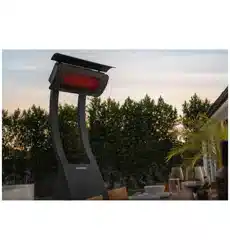Loading ...
Loading ...
Loading ...

22
bromic.com/heating-au
9. Over the life of the heater internal non-painted
parts may slightly discolour from high temperatures
emitted by the heater. This is a normal occurrence and
does not affect the operation of the appliance.
10. Replacement parts can be purchased to restore the
heater to its original appearance from Bromic Heating
Pty Ltd.
IMPORTANT
Service and repair should be done by a qualified service
person.
The heater should be inspected before use and at least
annually by a qualified service person.
More frequent cleaning may be required as necessary.
It is imperative that control compartment, burners and
circulating air passageways of the heater be kept clean.
!
MAINTENANCE AND SERVICING
It is important that regular maintenance is carried out on
the heater to maintain efficient operation. All maintenance
should be carried out ONLY by authorized service
personnel. Inspect and clean at least every six months or
more frequently in adverse conditions.
Never obstruct the flow of combustion and ventilation
air. Always keep the appliance area clear and free from
combustible materials, gasoline and other flammable
vapors and liquids. Do not clean heater with cleaners that
are combustible or corrosive.
REGULAR SERVICE REQUIREMENTS
1. The whole gas system, hose assembly, regulator, pipes,
and burner should be inspected for damage and leaks
before each use and at least annually by an authorized
person for the life of the heater. To check the gas
hose within the mounting arm, disassemble heater by
reversing the installation instructions as outlined in
installation section of this manual. The hose assembly
must be replaced prior to the appliance being put into
operation if there is evidence of excessive abrasion or
wear, or if the hose is damaged.The replacement hose
must be purchased from Bromic Heating Pty Ltd.
2. VISUALLY CHECK BURNER FLAMES.
During heaters function visually check that all burners
are alight and glowing hot. This can be done by
observing the red glow through the translucent face, or
by peering down the product combustion passageway.
Note: A slight variation in colour is to be expected.
3. Clean burners: Burners can be cleaned by directing
compressed air (max20PSI) at outlet ports. Avoid
directing air at gasket material between ceramic tile
and burner cup.
4. Clean manifold and injectors: Undo gas hose from gas
valve outlet (heater should be switched off) and inject
compressed air (max20PSI) down the inlet fittings.
5. Clean dust and foreign matter from inside of heater
housing: Open up rear housing and clear dust using
compressed air (max20PSI) and a damp cloth.
6. Remove debris, spider and insect nests from, control
compartment, burner and circulation air passageways
of the heater with heavy-duty pipe cleaner or
compressed air to keep appliance clean and safe
for use. Never clear ports or other openings with
toothpicks or other articles that will break and block the
ports.
7. In a salt-air environment, such as near an ocean,
corrosion occurs more quickly than normal. Remove
salt spray from the heater immediately to prolong
heater life. Check frequently for corroded areas and
repair them promptly.
8. The exterior components of the heater are constructed
from stainless steel, and high temperature black paint.
IMPORTANT
Do not apply any additional surface coating to the heater
under any circumstances. Use of additional coating other
than those applied during manufacture could result in
hazardous reactions such as toxic fumes or fires. Additional
coatings will void the warranty.
STORAGE
• There is no limitation on the storage of appliances indoors
provided that the cylinder is removed from the appliance.
• Storage of an appliance indoors with the cylinder attached
is only permitted if the size of the cylinder complies with AS/
NZS 1596; otherwise cylinders must be stored outdoors in a
well-ventilated area.
• Always close the gas valve on the gas cylinder after use.
• Remove the pressure regulator and hose assembly.
• Cylinder must be stored outdoors in a well-ventilated area
out of the reach of children.
• Disconnected cylinders must have threaded valve plugs
tightly installed and must not be stored in a garage or any
other enclosed area.
• Check the tightness of the gas valve and for damage. If
you suspect you have a damaged gas cylinder valve, contact
your place of purchase.
• Only store gas cylinders in places with adequate air
ventilation.
!
Loading ...
Loading ...
Loading ...
